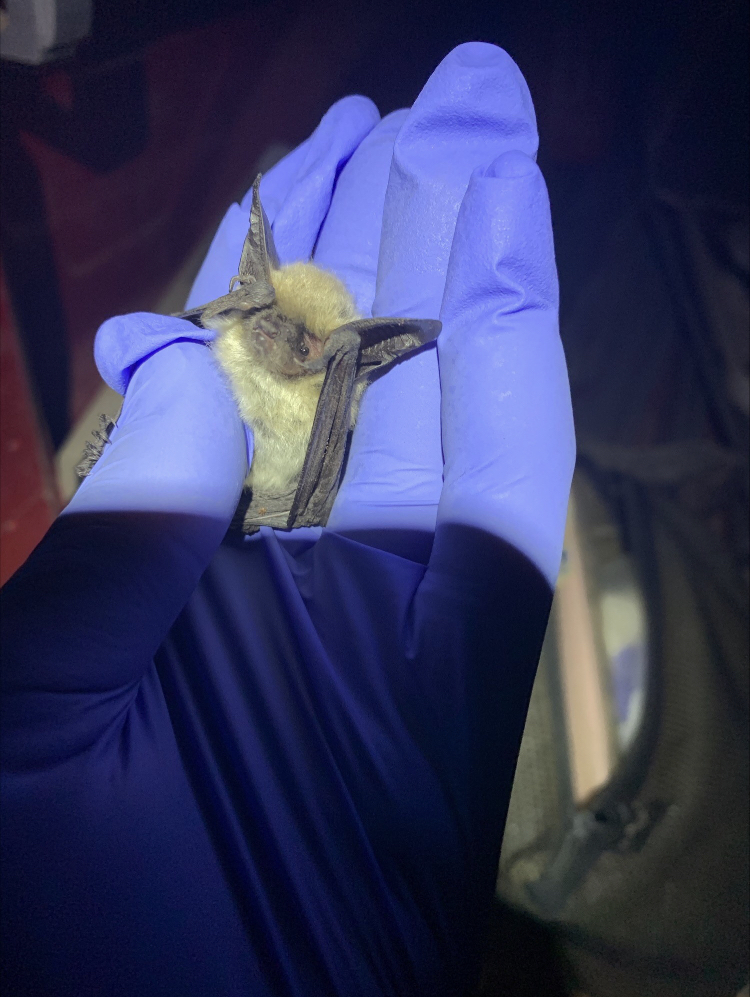Red Lodge, Montana, August 22, 2023—White-nose syndrome (WNS) was recently confirmed in Mystery Cave in the Pryor Mountains during a recent survey of bats. Mystery Cave, managed by the Bureau of Land Management (BLM), is one of a handful of caves in the Pryor Mountains in Montana that supports large numbers of hibernating bats during the winter, and is currently the largest known hibernaculum in the state, supporting approximately 600 myotis bats during winter. Biologists from Montana Fish, Wildlife & Parks (FWP) and the Montana Natural Heritage Program discovered the fungus/disease on bats in the cave during a survey conducted on June 14. Interagency efforts are ongoing to limit the disturbance of hibernating bats and to minimize the human-assisted spread of the fungus across Montana. Biologists will continue to survey Mystery Cave as part of long-term surveillance efforts.
WNS, the disease caused by the cold-adapted fungus, Pseudogymnoascus destructans (Pd), has killed millions of North American bats since its detection in New York in 2006. WNS has been confirmed in 40 states and eight Canadian provinces. Bat populations in Montana have been monitored in caves since the early 2000s. WNS was first detected in eastern Montana in the spring of 2021. Since 2020 the fungus has been detected in 20 Montana counties, and bats sick with WNS have been detected in six counties. Presence of the fungus Pd does not necessarily confirm the presence of the WNS disease.
The disease causes the growth of a white powdery fungus on the skin of hibernating bats, commonly found on their faces and wings. This results in irritation and dehydration, compelling bats to prematurely awaken from hibernation and thereby depleting the crucial fat reserves essential for survival in the winter. This often results in their death and the disease can wipe out entire colonies of bats causing dramatic population declines. WNS does not directly affect humans, pets, livestock or other wildlife.
Bats are found throughout Montana and are an important component of the ecosystem, biological diversity, and economy of the state, as they protect crops and timber by consuming large quantities of flying insect pests. FWP has found the fungus that causes WNS in four of Montana’s 15 bat species.
“It is more important than ever for people to avoid disturbing bats and to take precautions to prevent further spread of the fungus,” said Beartooth District Ranger Ken Coffin with the USDA Forest Service. “We’re working closely with other agencies, cave users, and local communities to responsibly protect bats from unnecessary exposure to WNS and to limit disturbance of bats to give them a fighting chance against the disease.”
Many bat populations are declining across the country. “We’ve held out hope that WNS will have less severe impacts on some of our western bat species because of differences in their roosting and hibernation ecology,” says Montana FWP Disease Ecologist Emily Almberg. “Alongside our disease surveillance efforts, we’ve been conducting acoustic monitoring and roost counts to track bat population trends. Unfortunately, our data to date suggests that the arrival of WNS has coincided with detectable declines among our susceptible bat populations in the eastern half of the state, mirroring patterns observed across much of the eastern part of the country.”
“Mystery Cave is gated and access has been restricted to this sensitive site for years,” said Acting District Manager Wendy Warren, based in Miles City. “The BLM, along with Montana FWP will continue to monitor the presence of WNS, like we have been doing in other bat studies in Eastern Montana and the Dakotas.”
The BLM and FWP annually monitor populations of bat species that reside in the Eastern Montana/Dakotas BLM District. This includes migratory bat populations that are seasonally present in the warmer months. Depending upon the species, bats can make use of a variety of habitat types for roosting, not just caves.
What you can do to help:
While humans and their pets are not affected by this fungus and the disease it causes, people can help prevent both from spreading by adopting the following precautions:
- Avoid entering caves that are used by bats between October 15 – May 1when bats are hibernating to help minimize disturbance.
- If you plan to enter a cave, it is important to:
- First decontaminate your shoes, clothes, backpacks, and other gear to reduce the risk of spreading any pathogen, including the spread of the fungus that causes WNS.
- Where possible, dedicate shoes and gear to a specific cave (or site) and do not use any potentially contaminated gear in a cave that has not yet been confirmed with bats or samples that have tested positive for the fungus that causes WNS.
- Decontamination information can be found atwww.whitenosesyndrome.org/static-page/decontamination-information
- If you see a dead or sick bat or group of bats, or find bats in unexpected places, don’t handle them and call a local FWP office for further guidance.
- FWP Wildlife Health Lab in Bozeman: 406-577-7882
- FWP Billings area office: 406-247-2940
For more information on white-nose syndrome, visit www.whitenosesyndrome.org/. For more information on Montana’s bats visit fieldguide.mt.gov



